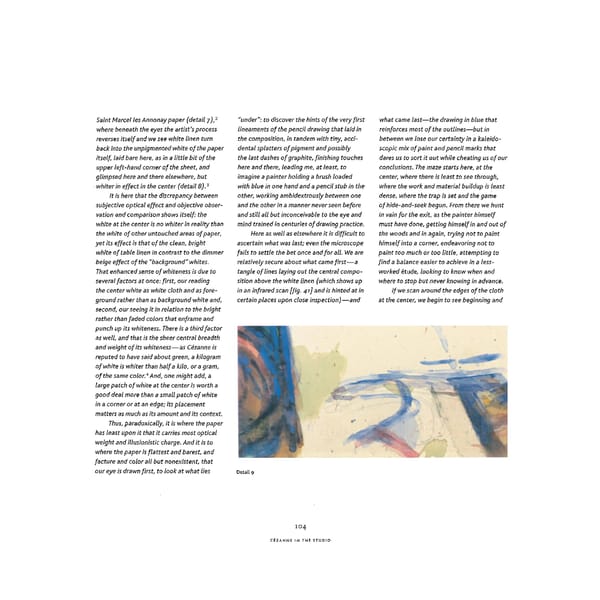Saint Marcel les Annonay paper (detail j),2 "under": to discover the hints of the very first what came last—the drawing in blue that where beneath the eyes the artist's process lineaments of the pencil drawing that laid in reinforces most of the outlines—but in reverses itself and we see white linen turn the composition, in tandem with tiny, acci- between we lose our certainty in a kaleido- back into the unpigmented white of the paper dental splatters of pigment and possibly scopic mix of paint and pencil marks that itself", laid bare here, as in a little bit of the the last dashes of graphite, finishing touches dares us to sort it out while cheating us of our upper left-hand corner of the sheet, and here and there, leading me, at least, to conclusions. The maze starts here, at the glimpsed here and there elsewhere, but imagine a painter holding a brush loaded center, where there is least to see through, whiter in effect in the center (detail 8).3 with blue in one hand and a pencil stub in the where the work and material buildup is least It is here that the discrepancy between other, working ambidextrously between one dense, where the trap is set and the game subjective optical effect and objective obser- and the other in a manner never seen before of hide-and-seek begun. From there we hunt vation and comparison shows itself: the and still all but inconceivable to the eye and in vain for the exit, as the painter himself white at the center is no whiter in reality than mind trained in centuries of drawing practice. must have done, getting himself in and out of the white of other untouched areas of paper, Here as well as elsewhere it is difficult to the woods and in again, trying not to paint yet its effect is that of the clean, bright ascertain what was last; even the microscope himself into a corner, endeavoring not to white of table linen in contrast to the dimmer fails to settle the bet once and for all. We are paint too much or too little, attempting to beige effect of the "background" whites. relatively secure about what came first—a find a balance easier to achieve in a less- That enhanced sense of whiteness is due to tangle of lines laying out the central compo- worked etude, looking to know when and several factors at once: first, our reading sition above the white linen (which shows up where to stop but never knowing in advance. the center white as white cloth and as fore- in an infrared scan [fig. 41] and is hinted at in If we scan around the edges of the cloth ground rather than as background white and, certain places upon close inspection)—and at the center, we begin to see beginning and second, our seeing it in relation to the bright rather than faded colors that enframe and punch up its whiteness. There is a third factor as well, and that is the sheer central breadth and weight of its whiteness—as Cezanne is reputed to have said about green, a kilogram of white is whiter than half a kilo, or a gram, 4 of the same color. And, one might add, a large patch of white at the center is worth a good deal more than a small patch of white in a corner or at an edge; its placement matters as much as its amount and its context Thus, paradoxically, it is where the paper has least upon it that it carries most optical weight and illusionistic charge. And it is to where the paper is flattest and barest, and facture and color all but nonexistent, that our eye is drawn first, to look at what lies Detail 9 104 CEZANNE IN THE STUDIO
 Cézanne in the Studio: Still Life in Watercolors Page 118 Page 120
Cézanne in the Studio: Still Life in Watercolors Page 118 Page 120